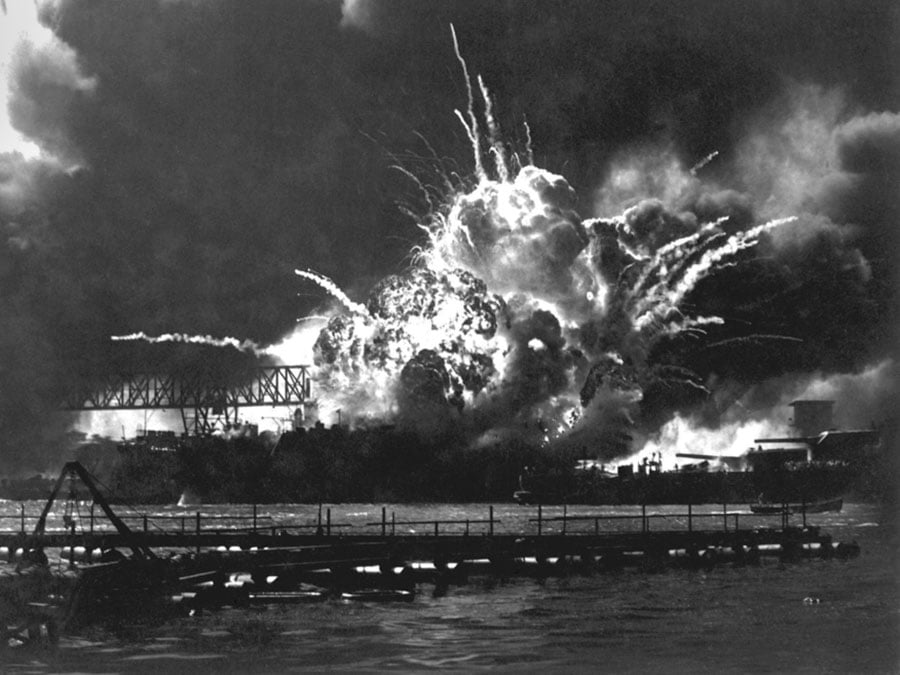By Robbin Laird
One way to remember December 7, 1941 is to go back to the actual day and recall the events.
December 7, 1941 dawned an ordinary Sunday for now-retired Lt. James “Jim” Downing and hearing his recount of the day is a very important way to remember the Day of Infamy.
Remembering Pearl Harbor from SldInfo.com on Vimeo.
Another way to remember is thinking through how to prepare for and anticipate tactical and strategic surprise.
Obviously, a surprise is just that, not something which you anticipate.
But the much used term for what the military is seeking to become is more agile, and certainly, agility is precisely having an ability to contemplate that tactical and strategic surprises are going to happen.
And how you respond, and how you think about response is crucial to overcoming whatever the initial effects come from a tactical or strategic surprise.
In a 2011 article, I argued the case for sharping a much more agile military, the one I would now label the integrated distributed force, precisely because of the certainty of strategic and tactical surprise.
The US is in a strategic upheaval over the nature of its futures and what future capabilities will remain after Afghanistan and the budget dynamics.
A key element to keep in mind – if the US wants to remain a strategic player globally – is how to rebuild its power projection forces.
But it is clear that it is not an old understanding of power project we are discussing but a fundamental transition of forces for projecting power for strategic dominance to a core competence to deploy agile forces to deal with black swans.

In the past two years, US forces have deployed to earthquakes, tsunamis, pick up wars, counter-piracy ops and a variety of impact points which could not have been planned in advance.
At the center of every response were agile commands, agile forces and agile capabilities. The difficulty is that every response to a Black Swan further degrades the remaining capabilities.
Operations drain the remaining capability of deployed assets. Leaders love to use the tools, but not to pay for their replacements.
It is more likely that Black Swans will continue to dominate our future, not 5-year Gosplans and insights from Commissions. To be ready for Black Swans you need agility.
Agile commands such as have built around the TACC, or the MEU structure are essential. More flexible command and control as used by the French or the USMC in the recent Libyan engagement.
Agile forces such as the Agile Response Group built around the newly enabled Amphibious Ready Group.
This is the building block for the future, not simply maintaining a legacy fleet with “geriatric” capabilities.
The new force structure built around leveraging new platforms can provide the needed agility.
The author of the Black Swan underscored that key impediment to learning is that we focus excessively on what we do know and that we tend to focus on the precise. We are not ready for the unexpected. For the author, the rare event equals uncertainty.
He argued that the extreme event as the starting point in knowledge not the reverse.
The author in the concluding parts of his second edition advocated redundancy as a core capability necessary for the kind of agile response one needs in a Black Swan Age.
The Black Swan: The Second Edition by Nassim Nicholas Taleb (Random House).
A recent statement by the Africom Commander that the Libyan operations were sui generis and not relevant to the future of warfare is a case in point of a guy who does not get it; the unexpected introduces change, one needs to embrace it and not conclude that THAT unexpected event is the norm, rather the response necessary to deal with the unexpected is what needs to be focused upon for force planners.
The key conclusion here is rather simple: we need to rebuilt our forces to be MORE agile, with more flexible C4ISR D and more flexible expectations of what engagements we are about to engage in.
And shaping plug and play capability with allies and partners becomes SIGNIFICANTLY more important in the period ahead.
And having significantly SCALEABILITY with regard to one’s forces would be a core advantage in responding to Black Swans. As an event emerges, the National
Command Authority responds with what make sense to them.
But then the situation evolves and the forces sent appear to be inadequate or the wrong ones.
The deployed force can reach up and out to scale a response.
And those forces can depart as new ones come.
One could easily argue that this will not happen the legacy systems which the US fights with have way to many stovepipes for agility, connectivity and coalition operations.
The featured photo was taken from the following source:
https://www.britannica.com/story/the-attack-on-pearl-harbor
For an interesting look at strategic surprise, see the following:
Intelligence-and-the-problem-of-strategic-surprise.pdf
For a CIA analysis of how intelligence needs to improve its approach to dealing with strategic surprise, see the following:
https://www.cia.gov/library/kent-center-occasional-papers/vol2no1.htm
And to follow up on my 2011 article, arguing for enhanced military agility, see my recent look at the amphibious task force as precisely enabling such a path:


